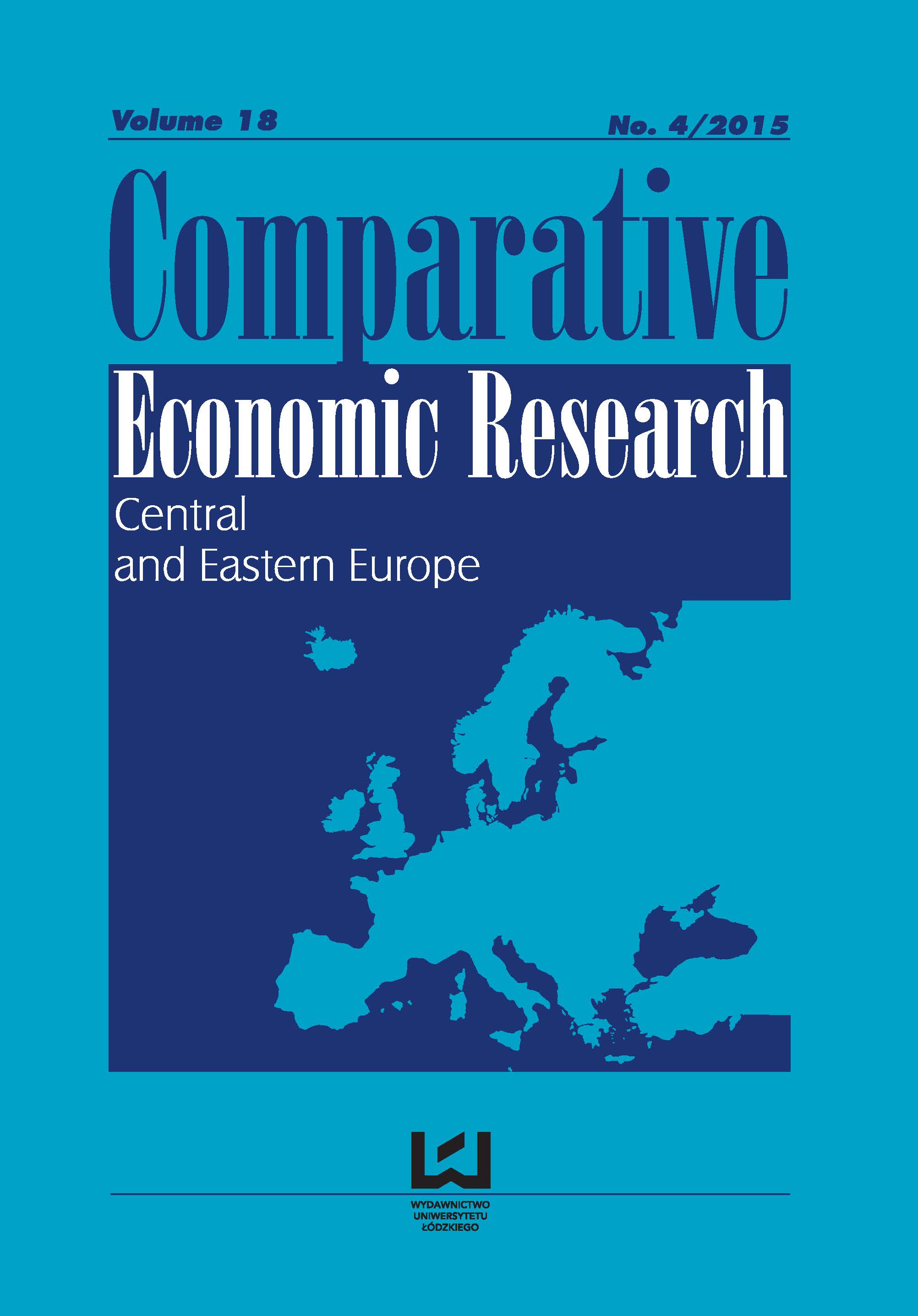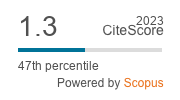Determinants Of European Banks' Capital Adequacy
DOI:
https://doi.org/10.1515/cer-2015-0030Keywords:
capital adequacy, Basel III, regulatory capital, leverage ratio, TierAbstract
This paper examines the factors affecting the Common Equity Tier 1 Ratio (CET1), which is a measure of the relationship between core capital and the risk-weighted assets of banks. The research is based on a randomly selected sample from the group of banks examined by the European Central Bank authorities. The ECB conducted stress tests assessing the CET1 Ratio with respect to the Basel III regulations. The findings confirm the hypothesis about the impact of bank size and the risk indicators (risk-weight assets to total assets ratio and the share of loans in total assets) on banks’ capital adequacy. They also confirm strong effect of competitive pressure and the negative correlation between the CET1 Ratio and the share of deposits in non-equity liabilities, which may be explained by the existence of the deposit insurance system. Finally the paper presents the limitations of the study and conclusions regarding possible further research in this subject area.
Downloads
References
Ahmad R., Ariff M., Skully M. (2009), Determinants of Bank Capital Ratios in a Developing Economy, ‘Asia-Pacific Financial Markets’, 15(3-4), pp. 255-272.
Google Scholar
Asarkaya Y., Ozcan S. (2007), Determinants of Capital Structure in Financial Institutions: The case of Turkey, ‘Journal of BRSA Banking and Financial Markets’, vol. 1, issue 1, p. 99.
Google Scholar
Barth J., Caprio G., Levine R. (2005), Rethinking Bank Regulation: Till Angels Govern, Cambridge University Press, Cambridge and New York.
Google Scholar
BCBS (1988), International Convergence of Capital Measurement and Capital Standards, Basel, pp. 15-16.
Google Scholar
BCBS (2010), Basel III: A global regulatory framework for more resilient banks and banking systems, p. 13.
Google Scholar
Berger A., DeYoung R. , Flannery M. (2007), Why do large banking organizations hold so much capital?, Working Paper, Board of Governors, FDIC and University of Florida.
Google Scholar
Berger A. N., Herring R.J. (1995), The role of capital in financial institutions, ‘Journal of Banking and Finance’ 19, pp. 393-430.
Google Scholar
Berger A.N., Herring R.J., Szego G. P. (1995), The Role of Capital in Financial Institutions, Wharton Working Paper, No 95-01.
Google Scholar
Capiga M. (2010), Zarządzanie bankiem, PWN, Warszawa.
Google Scholar
Diamond D., Rajan R. (2000), A theory of bank capital, ‘Journal of Finance’, 55, pp.2431-2465.
Google Scholar
European Banking Authority (2014), Results of 2014 EU - wide stress test, p. 7.
Google Scholar
Flannery M. (1994), Debt maturity and the deadweight cost of leverage: Optimally financing banking firms, ‘American Economic Review’, 84, pp.320-331.
Google Scholar
Flannery M., Rangan K. (2008), What caused the bank capital build-up of the 1990s?, ‘Review of Finance’, no 12, pp. 391-429
Google Scholar
Generalny Inspektorat Nadzoru Bankowego (2005), Drugi Filar Nowej Umowy Kapitałowej, DK/7/2F, p.4.
Google Scholar
Genest B., Brie L. (2013), Basel II IRB Risk Weight Functions. Demonstration and analysis, Global Research and Analytics, p.5.
Google Scholar
Gropp R., Heider F. (2008), The Determinants of Capital Structure: Some Evidence from Banks, Discussion Paper No. 08-015, Centre for economic European Research.
Google Scholar
Hennesy C., Whited T. (2005), Debt dynamics, ‘Journal of Finance’ 60, s.1129-1165. doi: 10.1111/j.1540-6261.2005.00758.X
Google Scholar
Iwanicz-Drozdowska M. (2004), Ewolucja regulacji w zakresie adekwatności kapitałowej banków, ‘Bezpieczny Bank’ nr 1(22), p. 90.
Google Scholar
Mili M., Sahut J.M., Trimeche H. (2014), Determinants of the Capital Adequacy Ratio of a Foreign Bank’s Subsidiaries: The Role of the Interbank Market and Regulation of Multinational Banks, IPAG Business School Working Paper 2014-366.
Google Scholar
Miller M. (1995), Do the M&M Propositions Apply to Banks?, ‘Journal of Banking and Finance’, 19 (3), pp.483-489.
Google Scholar
Mishkin F. (2000), The economics of money, banking and financial markets, Addison Wesley, New York, 6th edition.
Google Scholar
Murray Z. F., Goyal V. K. (2005), Tradeoff and Pecking Order Theories of Debt, Handbook of empirical corporate finance 2, p.17.
Google Scholar
Myers S.C. (1984), The capital structure puzzle, ‘Journal of Finance’, 39, pp. 575-592.
Google Scholar
Myers S., Rajan R. (1998), The paradox of liquidity, ‘Quarterly Journal of Economics’, 113, pp. 733-771.
Google Scholar
Osterbaerg P.W., Thompson B.J. (1990), Optimal Financial Structure and Bank Capital Requirements: An Empirical Investigation, Federal Reserve Bank of Cleveland Working Paper, no 9007.
Google Scholar
Resolution No. 76/2010 KNF, Appendix 20.
Google Scholar
Resolution No. 76/2010 KNF, Annex 20, Chapter II and III.
Google Scholar
Saunders A., Wilson B. (2001), An Analysis of Bank Charter Value and Its Risk-Constraining Incentives, ‘Journal of Financial Services Research’ 19, pp. 185-195. doi: 10.1023/A:1011163522271
Google Scholar
Van den Brink R.G.C., Arping S.R. (2009), What are the Determinants of the Tier 1 Capital Ratio in the Banking Sectors of the G10 and Switzerland from 2002 - 2008? , R.V. Bosch (0322164).
Google Scholar
Wong J., Choi K., Fong T. (2005), Determinants of the capital level in banks in Hong Kong, Hong Kong Monetary Authority Quarterly Bulletin, pp.14-37.
Google Scholar
http://www.snl.com/
Google Scholar
http://www.nbp.pl/home.aspx?f=/statystyka/pieniezna_i_bankowa/naleznosci.html (27.12.2014)]
Google Scholar
Downloads
Published
How to Cite
Issue
Section
License

This work is licensed under a Creative Commons Attribution-NonCommercial-NoDerivatives 4.0 International License.











